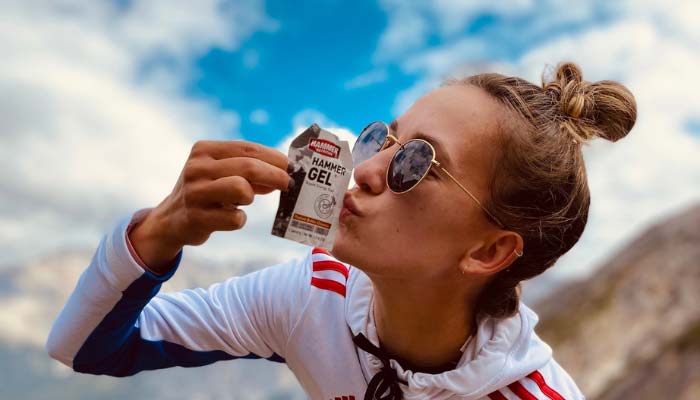BY MILES FRANK
At this point in the summer, we have taken calls, emails, live chats, instant messages, and letters asking for our help in fixing all the classic issues that plague endurance athletes. Those questions, along with a tortuously hot summer in most parts of the Northern Hemisphere, make for extra wacky antics, questions, and myths floating around. So, to debunk some myths and deliver time-tested, scientifically sound advice straight to you, I’ve compiled a few answers from our senior staff here at Hammer.
Myth
Some products claim it is the “most effective hydration solution for you” because they use “less sugar” or it’s “all you need all day,” yet their ingredient list starts with cane sugar (or any simple sugar that ends in “-ose”), citric acid, and salt.
Fact
Making a better product starts with the product, not the marketing. The calorie source you put in the body is important, as are the electrolytes you use to combat dehydration. Don't deplete your hydration by using low-quality, poorly thought-out products with fancy labels.
Myth
To avoid cramping in the summer, add 2,000 mg of salt to Sustained Energy.
Fact
This practice can make you feel bad in the last half of your event. Adding sodium chloride alone to any Hammer fuels may buffer signs of dehydration temporarily but in practice, it is far more likely to be detrimental to your stomach and therefore your performance.
Question
Can I consume Hammer Gel without needing to swallow it with water?
Answer
Yes. We were the first company to bring a gel to market that you could easily dilute for a thinner, “saucy” gel, or to just carry more gel. Heck, even mix flavors and make something even more delicious.
Question
Why doesn’t Hammer Gel have electrolytes already in it for hydration?
Answer
We have always opted to separate electrolytes from Hammer Gel to keep the flavor integrity—a salty gel is not only harder to consume but separating your electrolytes from your calories lets you adjust hydration better in cold and hot weather alike.
Myth
Use pickle juice for electrolyte replenishment to get through long/hot/intense events.
Fact
One ounce of pickle juice provides a staggering 877 mg of sodium! That’s roughly one-third of what you should consume DAILY. Not only that, but the portability, logistics, and lack of other essential electrolytes rules this out for most if not all hard-training athletes.
Additional Thoughts On Pickle Juice
Brian Frank:
The American College of Sports Medicine and American Heart Association suggest no more than 2,300–3,500 mg/day of sodium intake, the higher end being for high-volume training athletes. Your body does not manufacture sodium; therefore, it cannot excrete large quantities nor require large quantities to be replaced unless large quantities have first been consumed. High sodium diet = high sodium losses during exercise = necessity of high sodium replacement, AKA pickle juice! The safer, healthier, and more effective approach is to reduce dietary sodium to proper levels and then practice effective electrolyte replacement AT THE TIME OF LOSS.
Steve Born:
As you probably already know, the most common nutrient found in pickle juice is sodium. Pickle juice also contains a bit of potassium and small amounts of calcium, and magnesium. I would argue that there is far too much sodium in pickle juice at the expense of sufficient amounts of the other electrolytic minerals.
A mere 3.5 oz of pickle juice contains the following:
- carbohydrates: 0.4 grams
- calcium: 1%–5% of the recommended dietary intake (RDI)
- sodium: 50%–115% of the RDI
- potassium: 3% of the RDI
- magnesium: 3% of the RDI
As you can see, that is a TON of sodium—a minimum of 1,150 mg (50% of the RDA)—which is an astronomical amount, especially given that it is not balanced well at all with the other minerals.
This much sodium may (keyword “may”) temporarily resolve a cramping issue; however, it will most certainly disrupt the balance of all the minerals needed for many bodily functions—including proper muscular function—from operating properly.
For athletes consuming a high-sodium diet and/or have unusually high sweat rates, we recommend Endurolytes Extreme in capsule or powder form. You’ll get the additional sodium you need, potassium as well, but the amounts of both minerals are not high enough to disrupt the overall (and very important) balance of all the necessary electrolytic minerals.
Myth
Leading up to a hot-weather event, consume large quantities of water until your urine is clear.
Fact
Massively increasing water intake in a short period of time, indicated by clear urine, only serves to fill your bladder and eliminate critical electrolytic minerals from your body in the process. This can even lead to dangerous conditions like hyponatremia. Instead, you should seek to maintain normal hydration practices and ensure you always have a light-yellow hue to your urine. If you have clear urine before or during an event, it’s time to slow down the fluid intake and take more electrolytes on the spot!










